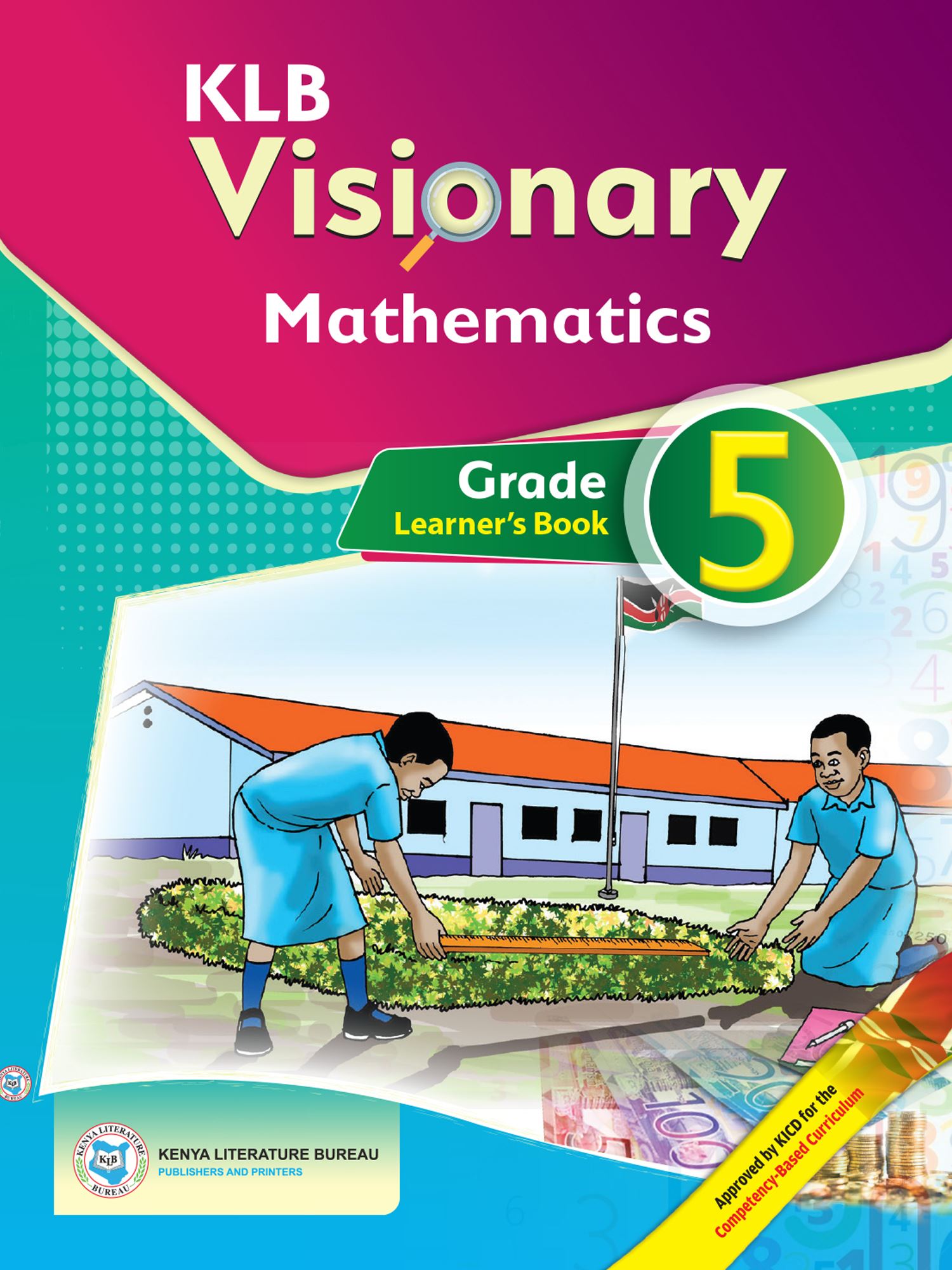
Authors
Obadiah Kiburi, Samuel Irumbi, Zipporah N. Muli, Francis MwangiExercises kit’s authors
Obadiah Kiburi, Samuel Irumbi, Zipporah N. Muli, Francis MwangiPublisher
Included in packages

-
The study kit contains 100 chapters and 936 exercises of which 701 are in the chapters and 235 in the task exercises.
-
Authors
Obadiah Kiburi, Samuel Irumbi, Zipporah N. Muli, Francis Mwangi -
Exercises kit’s authors
Obadiah Kiburi, Samuel Irumbi, Zipporah N. Muli, Francis Mwangi -
Subject
Mathematics -
Grade
Grade 5 -
Kit's language
English -
Publisher
Kenya Literature Bureau -
Included in packages
KLB Visionary Mathematics for Grade 5 Learner's Book is designed to help the learners acquire computational skills at this level. The book contains numerous activities that enable the learner to develop numeracy skills without undue difficulty.
• This book is developed in line with the requirements of the Competency Based Curriculum and subject design.
• The content is presented in a concise language appropriate to the level of the learner.
• The style is simple, making the book highly readable and the concepts easy to understand.
• The book contains full-colour illustrations designed to hold the attention and interest of the learners.
• The learner's book has employed a learner-centred approach where all experiences are centred on the learner's interests, knowledge and application to real life situations.
• Every lesson draws from day-to-day occurrences which form the basis for lesson introduction.
• The book has numerous practical activities and examples that enable the learner to learn on their own with minimum input from the teacher.
This Learner's Book is approved by the Kenya Institute of Curriculum Development (KICD). Other KLB titles approved by KICD in this grade are:
• KLB Visionary IRE Grade Five Learner's Book and Teacher's Guide
• KLB Visionary Kiswahili Grade Five Learner's Book and Teacher's Guide
• KLB Visionary English Grade Five Learner's Book and Teacher's Guide
• KLB Visionary Mathematics Grade Five Learner's Book and Teacher's Guide
• KLB Visionary Science and Technology Grade Five Learner's Book and Teacher's Guide
• KLB Visionary Music Grade Five Learner's Book and Teacher's Guide
• KLB Visionary Art and Craft Grade Five Learner's Book and Teacher's Guide
• KLB Visionary Physical and Health Education Grade Five Learner's Book and Teacher's Guide
• KLB Visionary Home Science Grade Five Learner's Book and Teacher's Guide
• KLB Visionary Agriculture Grade Five Learner's Book and Teacher's Guide
1. Numbers – Whole Numbers
2. Numbers – Addition
3. Numbers – Subtraction
4. Numbers – Multiplication
5. Numbers – Division
6. Numbers – Fractions
7. Numbers – Decimals
8. Measurement – Length
9. Measurement – Area
10. Measurement – Volume
Lead |
Chapter |
|---|---|
| 10.1. | Cubic Centimetre |
| 10.2. | Volume of Cubes and Cuboids Using the Formula |
| 10.3. | Volume of Cubes and Cuboids |
11. Measurement – Capacity
Lead |
Chapter |
|---|---|
| 11.1. | Millilitre |
| 11.2. | Litres and Millilitres |
| 11.3. | Conversion of Units of Capacity |
| 11.4. | Addition of Litres and Millilitres |
| 11.5. | Subtraction of Litres and Millilitres |
| 11.6. | Multiplication of Litres and Millilitres |
| 11.7. | Division of Litres and Millilitres |
12. Measurement – Mass
Lead |
Chapter |
|---|---|
| 12.1. | Measuring Mass in Grams |
| 12.2. | The Kilogram and the Gram |
| 12.3. | Addition of Grams and Kilograms |
| 12.4. | Subtraction of Grams and Kilograms |
| 12.5. | Multiplication of Grams and Kilograms |
| 12.6. | Division of Grams and Kilograms |
13. Measurement – Time
Lead |
Chapter |
|---|---|
| 13.1. | Measuring Time. Second. Minute |
| 13.2. | Conversion of Units of Time |
| 13.3. | Arithmetic with Time. Addition |
| 13.4. | Arithmetic with Time. Subtraction |
| 13.5. | Arithmetic with Time. Multiplication |
| 13.6. | Arithmetic with Time. Division |
14. Measurement – Money
Lead |
Chapter |
|---|---|
| 14.1. | Budget |
| 14.2. | Tax |
| 14.3. | Bank. Savings |
15. Geometry – Lines – Angles
Lead |
Chapter |
|---|---|
| 15.1. | Identifying and Drawing Horizontal and Vertical Lines |
| 15.2. | Perpendicular and Parallel Lines |
| 15.3. | Angles |
| 15.4. | Measuring Angles |
| 15.5. | Measuring Angles in Degrees |
16. Geometry – 3D Objects
Lead |
Chapter |
|---|---|
| 16.1. | 3D-Objects |
| 16.2. | Cuboid |
| 16.3. | Cube |
| 16.4. | Cylinder |
| 16.5. | Pyramid |
| 16.6. | Sphere |
17. Data Handling – Data Representation
Lead |
Chapter |
|---|---|
| 17.1. | Collection and Representation of Data Using Tables |
| 17.2. | Representation of Data Through Piling |
| 17.3. | Interpretation of Data Represented Through Piling |
18. Algebra – Simple Equations with One Unknown
Lead |
Chapter |
|---|---|
| 18.1. | Forming Simple Equations (1) |
| 18.2. | Forming Simple Equations (2) |
| 18.3. | Forming Simple Equations (3) |
| 18.4. | Solving Simple Equations (1) |
| 18.5. | Solving Simple Equations (2) |
| 18.6. | Solving Simple Equations (3) |
